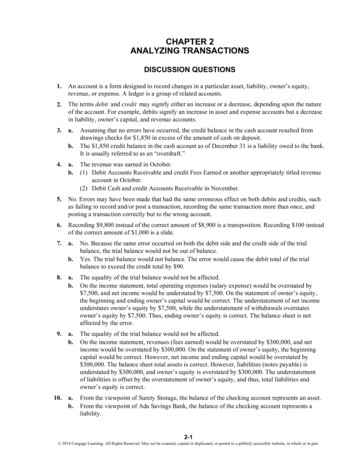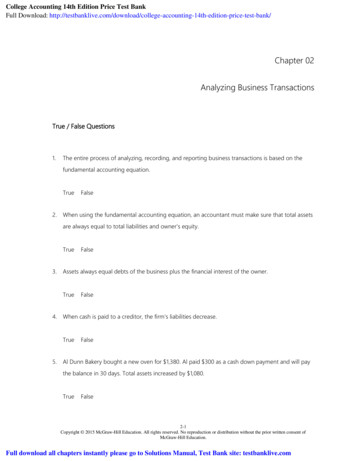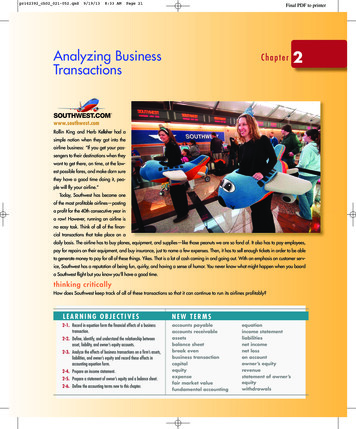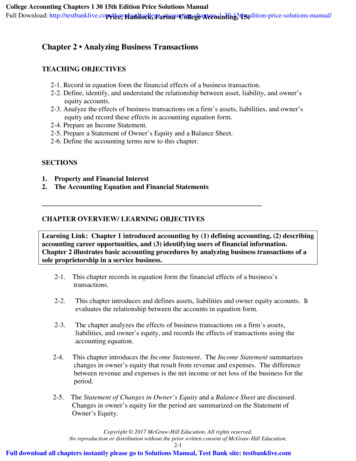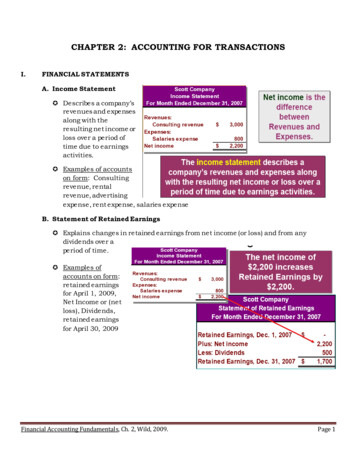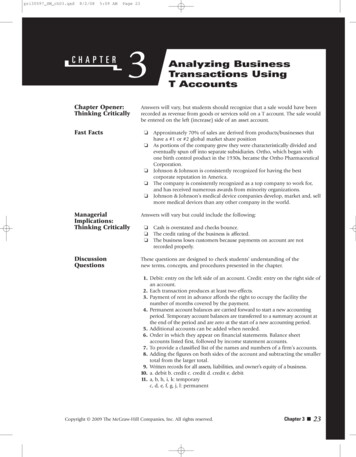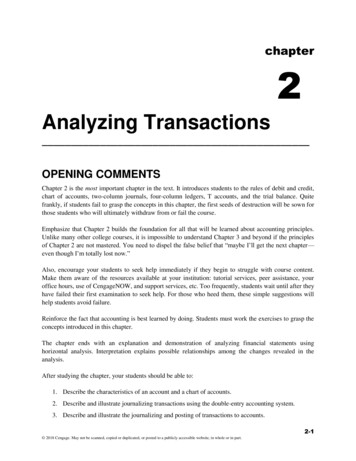
Transcription
chapter2Analyzing TransactionsOPENING COMMENTSChapter 2 is the most important chapter in the text. It introduces students to the rules of debit and credit,chart of accounts, two-column journals, four-column ledgers, T accounts, and the trial balance. Quitefrankly, if students fail to grasp the concepts in this chapter, the first seeds of destruction will be sown forthose students who will ultimately withdraw from or fail the course.Emphasize that Chapter 2 builds the foundation for all that will be learned about accounting principles.Unlike many other college courses, it is impossible to understand Chapter 3 and beyond if the principlesof Chapter 2 are not mastered. You need to dispel the false belief that “maybe I’ll get the next chapter—even though I’m totally lost now.”Also, encourage your students to seek help immediately if they begin to struggle with course content.Make them aware of the resources available at your institution: tutorial services, peer assistance, youroffice hours, use of CengageNOW, and support services, etc. Too frequently, students wait until after theyhave failed their first examination to seek help. For those who heed them, these simple suggestions willhelp students avoid failure.Reinforce the fact that accounting is best learned by doing. Students must work the exercises to grasp theconcepts introduced in this chapter.The chapter ends with an explanation and demonstration of analyzing financial statements usinghorizontal analysis. Interpretation explains possible relationships among the changes revealed in theanalysis.After studying the chapter, your students should be able to:1. Describe the characteristics of an account and a chart of accounts.2. Describe and illustrate journalizing transactions using the double-entry accounting system.3. Describe and illustrate the journalizing and posting of transactions to accounts.2-1 2018 Cengage. May not be scanned, copied or duplicated, or posted to a publicly accessible website, in whole or in part.
2-2Chapter 2Analyzing Transactions4. Prepare an unadjusted trial balance and explain how it can be used to discover errors.5. Describe and illustrate the use of horizontal analysis in evaluating a company’s performance andfinancial condition.KEY TERMSaccountaccount receivableassetsbalance of the accountcapital accountchart of accountscorrecting journal entrycreditdebitdouble-entry accounting systemdrawingexpensesfour-column accounthorizontal analysisjournaljournal entryjournalizingledgerliabilitiesnormal balance of an accountowner’s equitypostingrevenuesrules of debit and creditslideT accounttranspositiontrial balancetwo-column journalunadjusted trial balanceunearned revenueSTUDENT FAQS Why does Cash have a debit balance instead of a credit? My bank tells me they are crediting myaccount when I put money in. This question has to be answered several times until the student realizesthat to the bank it is a liability, and they are telling the student what they are doing to their books. Why is the abbreviation for a debit “Dr” when there is no “r” in the spelling? Why can’t the normal balances of all the accounts be opposite what they are? Who dreamed this accounting system up? 2018 Cengage. May not be scanned, copied or duplicated, or posted to a publicly accessible website, in whole or in part.
Chapter 2Analyzing Transactions2-3 Who uses these statements, and what do they do with the information? What is the difference between journalizing and posting? What is the difference between an expense and a liability? Aren’t assets and revenue the same? If a business works for someone and gets paid, aren’t Cash andRevenue exactly the same thing? Aren’t expenses and liabilities the same? If a business gets a utility bill and hasn’t paid it yet, aren’tUtility Expense and Utility Payable exactly the same account? Why do they call it a credit card? Who is crediting what? “I work in a bank and we use debits and credits, but you have them all reversed in the book. The bankwhere I work does everything exactly the opposite.” Why can’t we just record the transactions directly into the ledger? Why are the ledger accounts in a specific order? Why aren’t they listed in alphabetical order? Why aren’t increases ( ) always a debit and decreases (–) always a credit? Wouldn’t that make moresense? Why can’t you wait until the end of the month to compute the balance of each account in the ledger?Isn’t it a lot of work to re-compute a new balance after each posting? In business, we say that we need to raise capital to start a business, so why aren’t cash and capital thesame thing? How do I know whether to use wages expense or wages payable? Do small businesses really need to do all this work to keep track of their income? Can’t they just addand subtract from their bank account?OBJECTIVE 1Describe the characteristics of an account and a chart of accounts.SYNOPSISIn the previous chapter, transactions were recorded using the accounting equation format. This chapterdemonstrates how to record transactions using T accounts. Debits are recorded on the left side of the T,and credits are recorded on the right side of the T. The balance of the account is the amount of thedifference between the debits and the credits that have been entered into an account. All the accounts usedin a business are grouped together in a ledger. A list of the accounts in the ledger is known as a chart ofaccounts. The ledger contains all accounts used in the business. Assets are the resources owned by abusiness. Liabilities are the rights of creditors that represent debts of the business. Owner’s equity is theowner’s right to the assets of the business. For a proprietorship, the owner’s equity in the business isrepresented in the capital account; the drawing account represents the amounts that the owner haswithdrawn from the business. Revenues are increases in assets and owner’s equity as a result of sellingservices or products to customers. Expenses are assets used up or services consumed in the process of 2018 Cengage. May not be scanned, copied or duplicated, or posted to a publicly accessible website, in whole or in part.
2-4Chapter 2Analyzing Transactionsgenerating revenues. Each account in the chart of accounts is assigned an account number. Theseaccounts are used to record the business’s transactions.Key Terms and Definitions Account - An accounting form that is used to record the increases and decreases in eachfinancial statement item.Assets - The resources owned by a business.Balance of the account - The amount of the difference between the debits and the creditsthat have been entered into an account.Capital account - An account used for a proprietorship that represents the owner’s equity.Chart of accounts - A list of the accounts in the ledger.Credit - Amount entered on the right side of an account.Debit - Amount entered on the left side of an account.Drawing - The account used to record amounts withdrawn by an owner of a proprietorship.Expenses - Assets used up or services consumed in the process of generating revenues.Ledger - A group of accounts for a business.Liabilities - The rights of creditors that represent debts of the business.Owner’s equity - The owner’s right to the assets of the business.Revenues - Increases in assets from performing services or delivering products to customers.T account - The simplest form of an account.Relevant Exhibits Exhibit 1 – NetSolutions’ November TransactionExhibit 2 – Chart of Accounts for NetSolutionsSUGGESTED APPROACHRemind students that accounts are used to record business transactions. An account is simply a record ofall the increases and decreases in a financial statement item (such as cash, supplies, and accountspayable). A group of accounts is called a ledger.Point out that only a very small enterprise with very few transactions (such as a lawn-mowing service runby students) could use the accounting system illustrated in Chapter 1. For most businesses, this systemwould be inefficient. For example, in the prior chapter, all business transactions affecting owner’s equitywere recorded in the capital account. In Chapter 2, the different types of owner’s equity transactions willbe separated and recorded in the following accounts: capital, drawing, revenue, and expense accounts.Capital and revenue accounts increase owner’s equity; drawing and expense accounts reduce owner’sequity. This separation will make it easier to prepare financial statements. The following summary can beused to highlight this change.AccountCapitalDrawingRevenueExpenseUsed to RecordOwner’s investmentsOwner’s withdrawalsRevenues from customersExpenses incurred in the process of generating revenues 2018 Cengage. May not be scanned, copied or duplicated, or posted to a publicly accessible website, in whole or in part.
Chapter 2Analyzing Transactions2-5T accounts are introduced as a convenient way to track increases and decreases in accounts. You maywant to stress that T accounts are a representation of the general ledger, which is the official place torecord and track account balances.GROUP LEARNING ACTIVITY—Chart of AccountsObjective 1 also introduces a chart of accounts and a flexible system of numbering accounts. Under thetext’s indexing system, accounts are assigned a two-digit number. The first digit indicates the account’sclassification (1 assets, 2 liabilities, 3 owner’s equity, 4 revenue, and 5 expenses). Stress that allenterprises will have the same categories of accounts; however, the account titles used and the number ofaccounts will vary. You can emphasize this variety by asking students to bring in charts of accounts frombusinesses where they or a relative work.Handout 2-1 (at the end of this manual) presents information related to the business transactions of LarrySharp, M.D. You can use it as a handout or project it for your students. Divide students into small groupsand ask them to use the information to develop a chart of accounts for Dr. Sharp. Also ask them to assigna number to each account.This activity will test whether your students can identify the accounts needed to record Dr. Sharp’s typicalbusiness transactions and apply the concept of a flexible numbering system. The group activity may beassigned before discussing the information related to charts of accounts presented in the text. This willforce students to recall some information from their reading assignment and reinforce your expectationthat all reading assignments are to be completed prior to classroom discussion.Handout 2-2 presents a suggested chart of accounts that you may want to share with the class after theyhave completed their group work. Remind them that the chart of accounts is different for every company,reflecting each company’s typical business transactions.You will notice that Handout 2-2 does not include insurance expense or depreciation expense accounts.These accounts, although necessary for preparing adjusting entries, have been omitted since that step inthe accounting cycle will not be introduced until Chapter 3.The first account form introduced in Chapter 2 is the T account. Draw a T account on the board, andremind students that the left side will be called the debit or Dr. side and the right side will be called thecredit or Cr. side. Each T account has a name as well as a normal balance side.To demonstrate how a T account works, you may want to use the cash account and record the increasesand decreases to the account from one of the problems worked in Chapter 1 (1-3A, for example). Showhow the balance is recorded and compare it to the balance reached in the Chapter 1 problem. 2018 Cengage. May not be scanned, copied or duplicated, or posted to a publicly accessible website, in whole or in part.
2-6Chapter 2Analyzing TransactionsINTERNET ACTIVITY—Chart of AccountsMany organizations post recommended charts of accounts on the Internet, so your students can see somereal-world examples. A standard chart of accounts is provided by Small Business Notes. Its Web address mgmt/financialstmts/cofa.htmlYou might also want to encourage your students to search for other suggested charts of accounts.OBJECTIVE 2Describe and illustrate journalizing transactions using the double-entry accounting system.SYNOPSISBusinesses use the double-entry accounting system for recording transactions, based on recordingincreases and decreases in accounts so that debits equal credits. In this system, the rules of debit andcredit specify how to record debits and credits based on the type of account. The normal balance of anaccount can be either a debit or a credit depending on whether increases in the account are recorded asdebits or credits. For asset and expense accounts, a debit increases the account, and a credit decreases theaccount. For liability, owner’s equity, and revenue accounts, a debit decreases the account, and a creditincreases the account. The word debit can be abbreviated as Dr., and credit can be abbreviated as Cr.Using the rules of debit and credit, transactions are entered in a journal; this is the initial record in whichthe effects of a transaction are recorded. The process of entering a transaction is called journaling. Eachsuch record is known as a journal entry. The transaction is recorded using the following steps: the date ofthe transaction is recorded in the Date column, the title of the account to be debited is entered first in theDescription column, and the amount to be debited is entered in the Debit column. The title of the accountto be credited is listed under the account debited and indented and the amount to be credited is entered inthe Credit column. A brief description may be entered at this time in the Description column below theaccount credited. The Post. Ref. column is not used until the entry is transferred to the ledger.Key Terms and Definitions Double-entry accounting system - A system of accounting for recording transactions, based onrecording increases and decreases in accounts so that debits equal credits.Journal - The initial record in which the effects of a transaction are recorded.Journal entry - The form of recording a transaction in a journal.Journalizing - The process of recording a transaction in the journal.Normal balance of an account - The normal balance of an account can be either a debit or acredit depending on whether increases in the account are recorded as debits or credits.Rules of debit and credit - In the double-entry accounting system, specific rules for recordingdebits and credits based on the type of account.Two-column journal - A journal format with a debit column and a credit column. 2018 Cengage. May not be scanned, copied or duplicated, or posted to a publicly accessible website, in whole or in part.
Chapter 2Analyzing Transactions2-7Relevant Example Exercises and Exhibits Exhibit 3 – Rules of Debit and Credit, Normal Balances of AccountsExample Exercise 2-1 – Rules of Debit and Credit and Normal BalancesExhibit 4 – Transaction Terminology and Related Journal Entry AccountsExample Exercise 2-2 – Journal Entry for Asset PurchaseSUGGESTED APPROACHLearning the rules of debit and credit is one of the first major hurdles for students in accountingprinciples. Remind students that debit and credit simply represent the left and right sides of an account.The trick is remembering which accounts are increased with debits and which are increased with credits.LECTURE AID—Rules of Debit and CreditThree approaches to explain the rules of debit and credit follow. You may want to present all methods toyour class and encourage each student to use the approach that he or she understands best.“Mirror Image” Approach: One way to explain the rules of debit and credit is to draw the followingequation on the board.Assets –Liabilities– Owner’s Equity– Point out that the rules for increasing and decreasing liabilities and owner’s equity accounts are the mirrorimage of the rules for assets. Therefore, if students can remember the rules for assets, they can deduce therules for the remaining accounts. This method requires that the student understand that the negative effectof the drawing and expense accounts on owner’s equity requires the opposite treatment of the rules ofdebit and credit for these types of accounts. Exhibit 3 from the text is excellent to help explain thisconcept.Although this is the most simplistic approach, some students become very confused by the treatment ofthe drawing and expense accounts. Increases to these accounts are debits, since they reduce owner’sequity. However, some students want to record expenses and drawings as credits because the schematichas a sign on the credit side of owner’s equity accounts. 2018 Cengage. May not be scanned, copied or duplicated, or posted to a publicly accessible website, in whole or in part.
2-8Chapter 2Analyzing Transactions“After Eating Dinner” Approach: The rules of debit and credit can also be explained with the followingsaying: “After eating dinner, let’s read the comics.”Here’s how it works.After Eating Dinner,Let’s Read the ComicsAccounts increasedwith a debit:AssetsExpensesDrawingsAccounts increasedwith a credit:LiabilitiesRevenuesCapital“ALICE” Approach: The rules of debit and credit can also be explained using the acronym “ALICE.”List the types of classifications of accounts:A AssetsL LiabilitiesC Capital (Owner’s Equity)I Income (Revenue)E ExpenseArrange the letters to read “ALICE.” Then list normal balances by the side of each.ALICE Dr.Cr.Cr.Cr.Dr.Note that ALICE begins and ends with normal Dr. balance accounts, while the three middleclassifications are normal Cr. balance accounts. The drawing account is not included in this explanation,so the student must memorize the proper treatment of this account.No matter which approach the student uses to learn the rules, you will need to reinforce the categories andthe proper treatment of increases and decreases over and over. Start by emphasizing that half of theaccounts are increased with debits (assets, drawing, and expenses) and half are increased with credits(liabilities, capital, and revenue). It is also important to discuss the meaning of normal balance. Normalbalance is the entry that increases the account. At this point in the learning process, the student canassume that only assets and liabilities will have both debit and credit entries. Drawing and expenseaccounts will have only debit entries, and capital and revenue accounts will have only credit entries. Thisgeneralization will hold true until Chapter 4. By that time, the student should be comfortable with thedebit and credit rules. 2018 Cengage. May not be scanned, copied or duplicated, or posted to a publicly accessible website, in whole or in part.
Chapter 2Analyzing Transactions2-9GROUP LEARNING ACTIVITY—Rules of Debit and CreditAfter explaining the rules of debit and credit, it is important to reinforce those concepts with an example.Remind students that business transactions are initially recorded in a record called a journal. After eachentry is journalized, it is posted to the proper account in the ledger. In this group exercise, students willpost entries into a T account.Ask your students to draw the following T accounts on a sheet of paper:CashAccounts ReceivableSuppliesStereo EquipmentAccounts PayableM. Gordon, CapitalM. Gordon, DrawingFees EarnedWages ExpenseAdvertising ExpenseHandout 2-3 lists several business transactions, which you can project on the board or use as a handout.Illustrate the process by recording the first two or three transactions in a journal format and by postingthem to the appropriate T account. As you work these examples, emphasize that there is a three-stepprocess in analyzing each entry: (1) determine which accounts are affected, (2) decide whether eachaccount should be increased or decreased, and (3) translate the increase or decrease into a debit or acredit.Students may find it helpful when initially analyzing transactions to first see if the transaction involvescash. Most transactions in this stage of learning involve cash. If cash is being received, the debit portionof the transaction is cash. If cash is being given, the credit portion of the transaction is cash. This willprovide students with half the transaction entry and allow them to focus on determining the other accountto complete the journal entry.After completing your examples, ask students to work in small groups to complete the transactions.Handout 2-4 presents the solution to this exercise.LECTURE AID—Double-Entry AccountingTo help the student understand the effect of double-entry accounting, it can be helpful to illustrateexamples of some more common transactions, such as the ones below, as you lecture.TRANSACTIONAFFECTED ACCOUNTSDr.Deposited cash in an accountin the name of the business.CashCr.Dr.Increase 2018 Cengage. May not be scanned, copied or duplicated, or posted to a publicly accessible website, in whole or in part.Owner’s CapitalCr.Increase
2-10Chapter 2Analyzing TransactionsTRANSACTIONAFFECTED ACCOUNTSCashCr.Dr.Received cash for servicesrendered.IncreaseIncreaseAccounts ReceivableDr.Cr.Billed customers on account.DecreaseCashCr.Dr.Expense AccountCr.Dr.IncreaseAccounts ReceivableDr.Cr.IncreaseDecreaseCashCr.Dr.Paid on account.DecreaseDr.SuppliesCr.Dr.Accounts PayableCr.DecreaseDr.Accounts PayableCr.IncreaseDr.Withdrew cash for personal use.IncreaseCashCr.Paid for expenses.Purchased on account.Fees EarnedCr.Dr.IncreaseDr.Received cash on account.Fees EarnedCr.Dr.IncreaseCashCr.DecreaseDr.Owner’s DrawingCr.Increase 2018 Cengage. May not be scanned, copied or duplicated, or posted to a publicly accessible website, in whole or in part.
Chapter 2Analyzing Transactions2-11LECTURE AID—JournalizingAt this point, it is time to introduce your students to the standard journal format. It is interesting to pointout that while T accounts are not actually used to record business transactions, accountants frequently usethem to analyze complex transactions. In the same way, students will find the T account a useful toolthroughout this and future accounting courses.You may wish to point out Exhibit 4 in the text that summarizes common transaction terminology.Handout 2-5 shows a series of transactions recorded in a two-column journal. Use this exhibit to reviewthe two-column journal format with your students. You may want to stress the following format issues:1. Dates: The year is entered only at the top of the Date column. The month is entered on the first line ofthe Date column on each page; it is also entered for the first transaction whenever changing to a newmonth. The date is entered for each transaction.2. The Description column is where account names are entered. Debited accounts should be on top, andcredited accounts should be on the bottom and indented to the right (credits are always on the right).(In CengageNOW, when an amount is entered in the Credit column, the account name willautomatically indent.)3. Proper journalizing always has at least one debit and one credit, and total debits must always equaltotal credits. Proper journalizing will keep the accounting equation in balance.4. Explanations: A brief description of the transaction should be written below the debit and creditaccount titles. This description may be omitted if the transaction is a normal business occurrence andits nature is obvious from the entry. When calculations are required, they should be noted here.(Explanations are not required in CengageNOW.)5. Blank Lines: A blank line should separate all transactions in a manual journal to make them easier toread. Computerized systems are normally designed to separate journal entries without special input.(Blank lines are not required in CengageNOW.)It is also helpful to emphasize the importance of using the correct journal entry format of left justifyingdebits and indenting credits by writing the following entry on the board and asking students to identifywhat is wrong:SuppliesCash500500Since the credit in the entry is not indented, it is difficult to identify the debit and the credit. Weresupplies purchased using cash, or were they sold for cash?In most computerized systems, the indention of the names of accounts credited is not necessary becausedebits and credits are recorded in separate columns. 2018 Cengage. May not be scanned, copied or duplicated, or posted to a publicly accessible website, in whole or in part.
2-12Chapter 2Analyzing TransactionsOBJECTIVE 3Describe and illustrate the journalizing and posting of transactions to accounts.SYNOPSISThis objective continues with journalizing and also demonstrates how to post the journal entries to theledger. Posting is the process of transferring the debits and credits from the journal entries to the accounts.Using the company NetSolutions, the chapter shows the journalizing of a transaction in a standardaccount form and then demonstrates how to record each entry in the ledger. The debits and credits fromeach entry are transferred to the ledger in the order in which they occurred. The ledger account is locatedfor the first line of the entry, the date is transferred first, then the amount of the debit is entered in theDebit column, the journal page is entered in the Posting Reference (Post. Ref.) column of the ledger, andthe account number is entered in the Post. Ref. column in the journal. The ledger account is located forthe second line of the entry, the date is transferred first, then the amount of the credit is entered in thecredit Column, the journal page is entered in the Post. Ref. column of the ledger, and the account numberis entered in the Post. Ref. column in the journal.Several transactions are analyzed. The transaction in which NetSolutions rents land to another entity forthree months introduces the concept of unearned revenue. This transaction creates a liability by receivingrevenue in advance. As the three months passes, the liability will decrease and become revenue. Thetransaction in which NetSolutions agrees that a customer may receive services and pay at a later datecreates an account receivable. This is a claim against the customer created by selling merchandise orservices on credit. This account is an asset, and the revenue is earned even though no cash is yet received.Key Terms and Definitions Account receivable - A claim against the customer created by selling merchandise or services oncredit.Four-column account - An account format used for posting journal entries with columns fordebits, credits, and a debit or credit balance.Posting - The process of transferring the debits and credits from the journal entries to theaccounts.Unearned revenue - The liability created by receiving revenue in advance.Relevant Example Exercises and Exhibits Exhibit 5 – Diagram of the Recording and Posting of a Debit and a Credit Ledger, NetSolutionsExample Exercise 2-3 – Journal Entry for Fees EarnedExample Exercise 2-4 – Journal Entry for Owner’s WithdrawalExhibit 6 – General Ledger for NetSolutions on December 31, 2018Example Exercise 2-5 – Missing Amount from an Account 2018 Cengage. May not be scanned, copied or duplicated, or posted to a publicly accessible website, in whole or in part.
Chapter 2Analyzing Transactions2-13SUGGESTED APPROACHRemind students that journalizing transactions is a sequential record of business dealings and posting isthe updating of individual account balances. Getting the journal entry correct is the bigger challenge; theposting is a merely a process of transferring the information from the journal to the proper ledgeraccounts. Although posting can be a tedious process, it is critical that the student follow the process andnot resort to shortcuts; otherwise, information may be omitted, resulting in incorrect account balances.DEMONSTRATION PROBLEM—The LedgerHandout 2-6 is a series of four-column ledger accounts. Use these blank accounts to demonstrate postingof the first three transactions from Handout 2-5. As you post the transactions, remind students that aposting reference must be entered in the appropriate columns of both the journal and the ledger. Also,emphasize that transactions should be posted carefully to avoid errors. Careless posting may result in a lotof time being wasted trying to find errors. Emphasize that with a software package, posting will usuallybe done automatically, so there is less chance of making mistakes in posting.WRITING EXERCISE—The Journal and the LedgerIt is important for students to understand the reason that business transactions are recorded in a journal asthe book of original entry and later posted to a ledger. To check their understanding of these concepts, askthem to write a response to the following questions.1. Why are business transactions initially recorded in a journal?2. Why are business transactions posted from the journal to a ledger?Question 1 possible response: The journal is used to record transactions in the order in which theyoccur. The journal shows the entire effect of the transaction and how the transaction impacts theaccounting equation. Without the journal, the general ledger accounts would not reflect the entire historyof the transaction.Question 2 possible response: The ledger tracks the balance of the individual accounts. Without postinga transaction to the ledger, the accountant would have to go back and track every individual transaction tofind those that impact the account in question and track the increases and decreases over the accountingperiod to determine the balance in the account.GROUP LEARNING ACTIVITY—The Journal and the LedgerThis activity presents another method to emphasize the purpose of the journal and the ledger in theaccounting process. Handout 2-7 lists questions a business owner might ask that can be answered byexamining the company’s accounting records. Your st
Analyzing Transactions _ OPENING COMMENTS Chapter 2 is the most important chapter in the text. It introduces students to the rules of debit and credit, chart of accounts, two-column journals, four-column ledgers, T accounts, and the trial balance. . business transactions and apply the concept of a flexible numbering system. The group .
